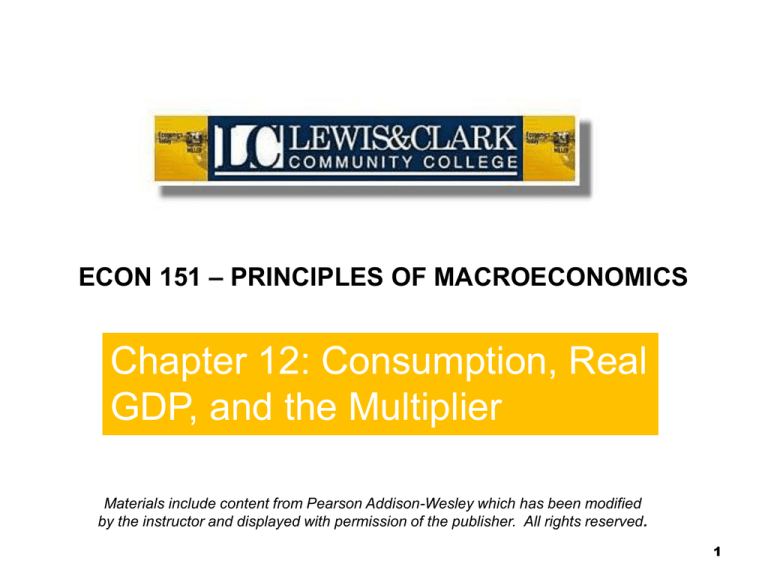
End of
ECON 151 – PRINCIPLES
OF MACROECONOMICS
Chapter
10
Chapter 12: Consumption, Real
GDP, and the Multiplier
Materials include content from Pearson Addison-Wesley which has been modified
by the instructor and displayed with permission of the publisher. All rights reserved.
1
1
Some Simplifying Assumptions
in a Keynesian Model
To simplify the income determination model
1.
Businesses pay no indirect taxes (sales tax)
2.
Businesses distribute all profits to shareholders
3.
There is no depreciation
4.
The economy is closed; no foreign trade
12-2
Some Simplifying Assumptions
in a Keynesian Model (cont'd)
Real Disposable Income
Real
GDP minus net taxes, or after-tax
real income
Consumption
Spending
on new goods and services out of a
household’s current income
Whatever
is not consumed is saved.
Consumption
includes such things as buying food and
going to a concert.
12-3
Some Simplifying Assumptions
in a Keynesian Model (cont'd)
Saving
The act of not consuming all of one’s current income
Whatever is not consumed is, by definition, saved.
Saving is an action measured over time (a flow).
Savings are a stock, an accumulation resulting from the
act of saving in the past.
Dissaving
Negative saving; a situation in which spending exceeds
income
12-4
Some Simplifying Assumptions
in a Keynesian Model (cont'd)
Consumption plus saving equals
disposable income.
Saving equals disposable income minus
consumption.
12-5
Some Simplifying Assumptions
in a Keynesian Model (cont'd)
Consumption Goods
Goods
bought by households to use up, such
as food and movies
Capital Goods
Producer
durables; nonconsumable goods
that firms use to make other goods
12-6
Some Simplifying Assumptions
in a Keynesian Model (cont'd)
Investment
Spending
by businesses on things such
as machines and buildings, which can
be used to produce goods and services in the
future
The
investment part of real GDP is the portion
that will be used in the process of producing
goods in the future.
12-7
Spending on Human Capital:
Investment or Consumption?
Economists define human capital as the
accumulation of investments and training
in education.
From this perspective, educational
expenses should be regarded as a form
of investment spending.
Nevertheless, in official U.S. government
statistics, household spending on education is
classified as consumption.
12-8
Determinants of Planned Consumption and
Planned Saving
In the classical model, the supply of saving was
determined by the rate
of interest.
The
higher the rate, the more people wanted to save,
the less they wanted
to consume.
Keynes argued that real saving and consumption
decisions depend primarily on a household’s real
disposable income.
12-9
Determinants of Planned Consumption and
Planned Saving (cont'd)
Keynes was concerned with changes
in AD as reflected in planned expenditures.
His initial focus was on Consumption.
AD = C + I + G + X
12-10
Determinants of Planned Consumption and
Planned Saving (cont'd)
Consumption Function
The
relationship between amount consumed
and disposable income
A
consumption function tells us how much
people plan to consume at various levels of
disposable income.
12-11
Determinants of Planned Consumption and
Planned Saving (cont'd)
Dissaving
Negative
saving; a situation in which spending
exceeds income
Dissaving
can occur when a household is
able to borrow or use up existing assets.
12-12
Table 12-1 Real Consumption and Saving
Schedules: A Hypothetical Case
12-13
Determinants of Planned Consumption and
Planned Saving (cont'd)
45-Degree Reference Line
The
line along which planned real
expenditures equal real GDP per year
On
the following graph, DPI is labeled as YD.
However, under the Keynesian simplifying
assumptions, when all components of AD are
reflected, the label becomes Y for real GDP.
12-14
Determinants of Planned Consumption and
Planned Saving (cont'd)
Autonomous Consumption
The
part of consumption that is independent
of the level of disposable income
Changes
in autonomous consumption
shift the consumption function.
12-15
Figure 12-1
The Consumption
and Saving
Functions
12-16
Figure 12-1 The Consumption
and Saving Functions (cont'd)
12-17
Figure 12-1 The Consumption
and Saving Functions (cont'd)
12-18
Determinants of Planned Consumption and
Planned Saving (cont'd)
Average Propensity to Consume (APC)
Real
consumption divided by real disposable
income
The
proportion of total disposable income that
is consumed
Real consumption
APC =
Real disposable income
12-19
Determinants of Planned Consumption and
Planned Saving (cont'd)
Average Propensity to Save (APS)
Real
saving divided by real disposable
income (DI)
Saved
proportion of real DI
Real saving
APS =
Real disposable income
12-20
Determinants of Planned Consumption and
Planned Saving (cont'd)
Marginal Propensity to Consume (MPC)
The
ratio of the change in real consumption to
the change in real disposable income
MPC =
Change in real consumption
Change in real disposable income
12-21
Determinants of Planned Consumption and
Planned Saving (cont'd)
Marginal Propensity to Save (MPS)
The
ratio of the change in saving to the
change in disposable income
MPS =
Change in real saving
Change in real disposable income
12-22
Determinants of Planned Consumption and
Planned Saving (cont'd)
Some relationships
Average
propensity to consume and average
propensity to save must sum to 100% of total
income. (APC + APS = 1)
Marginal
propensity to consume and marginal
propensity to save must sum to 100% of the
change in income. (MPC + MPS = 1)
12-23
Determinants of Planned Consumption and
Planned Saving (cont'd)
Causes of shifts in the consumption
function
A
change besides real disposable income will
cause the consumption function
to shift.
Non-income
Population
Wealth
determinants of consumption
12-24
Determinants of Planned Consumption and
Planned Saving (cont'd)
Wealth
The
stock of assets owned by a person,
household, firm or nation
For
a household, wealth can consist of a
house, cars, personal belongings, stocks,
bonds, bank accounts, and cash.
12-25
Determinants of Investment
Investment, you will remember, consists of
expenditures on new buildings and
equipment.
Gross
private domestic investment has been
volatile.
Consider
the planned investment function,
and shifts in the function.
12-26
Figure 12-2
Planned Real Investment, Panel (a)
12-27
Figure 12-2
Planned Real Investment, Panel (b)
12-28
Determining Equilibrium
Real GDP (cont'd)
Adding the investment function
AD = C + I + G + X
12-29
Figure 12-4 Combining
Consumption and Investment
12-30
Determining Equilibrium
Real GDP (cont'd)
Saving and investment: planned
versus actual
Only
at equilibrium real GDP will planned
saving equal actual saving.
Planned
investment equals actual investment.
Hence
planned saving is equal to planned
investment.
12-31
Figure 12-5 Planned and Actual Rates of
Saving and Investment
12-32
Determining Equilibrium Real GDP (cont'd)
Unplanned increases in business inventories
Consumers
purchase fewer goods and services
than anticipated
This
leaves firms with unsold products
Unplanned decreases in business inventories
Business
will increase production of goods and
services and increase employment
12-33
Keynesian Equilibrium with Government and
the Foreign Sector Added
To this point we have ignored the role of
government in our model.
We also left out the foreign sector of the
economy in our model.
Let’s think about what happens when we
add these elements.
12-34
Keynesian Equilibrium with Government and
the Foreign Sector Added (cont'd)
Government (G): C + I + G
Federal,
state, and local
Does not include transfer payments
Is autonomous
Lump-sum taxes = G
Lump-Sum Tax
A
tax that does not depend on income or the
circumstances of the taxpayer
12-35
Keynesian Equilibrium with Government and
the Foreign Sector Added (cont'd)
The Foreign Sector: C + I + G + X
Net
exports (X) equals exports
minus imports
Depends
on international economic conditions
Autonomous—independent
of real
national income
12-36
Table 12-2 The Determination
of Equilibrium Real GDP with Government and
Net Exports Added
12-37
Keynesian Equilibrium with Government and
the Foreign Sector Added (cont'd)
Determining the equilibrium level of GDP
per year
We
are now in a position to determine the
equilibrium level of real GDP per year.
Remember
that equilibrium always occurs
when total planned real expenditures equal
real GDP.
12-38
Figure 12-6
The Equilibrium Level of Real GDP
Recall that planned AD
=C+I+G+X
Although not identified
as such by Keynes, the
45-degree reference
line can be thought of
as actual expenditures
or AS.
Equilibrium will occur
where AD = AS.
12-39
The Equilibrium Level of Real
GDP
Observations
If
C+I+G+X=Y
If
C+I+G+X>Y
If
Equilibrium GDP
Unplanned drop in inventories
Businesses increase output
Y returns to equilibrium
C+I+G+X<Y
Unplanned rise in inventories
Businesses cut output
Y returns to equilibrium
12-40
The Multiplier
Multiplier
The
ratio of the change in the equilibrium level
of real national income to the change in
autonomous expenditures
The
number by which a change in
autonomous real investment or autonomous
real consumption is multiplied to get the
change in equilibrium real GDP
12-41
Table 12-3 The Multiplier
Process
12-42
The Multiplier (cont'd)
The multiplier formula
1
1
Multiplier =
=
1 - MPC
MPS
12-43
The Multiplier (cont'd)
By taking a few numerical examples, you
can demonstrate to yourself an important
property of the multiplier.
The
smaller the MPS, the larger
the multiplier.
The
larger the MPC, the larger
the multiplier.
12-44
The Multiplier (cont'd)
Measuring the change in
equilibrium income from a
change in autonomous spending
Change in equilibrium real GDP =
Multiplier x Change in autonomous spending
12-45
The Multiplier (cont'd)
Significance of the
multiplier
It
is possible that a
relatively small
change in
consumption or
investment can
trigger a much
larger change in
real GDP.
12-46
How a Change in Real Autonomous Spending
Affects Real GDP When
the Price Level Can Change
So far our examination of how changes
in real autonomous spending affects equilibrium
real GDP has considered a situation in which the
price level remains unchanged.
Our equilibrium analysis has only considered
how AD shifts in response to autonomous
consumption, investment, government spending,
net exports.
12-47
How a Change in Real Autonomous Spending
Affects Real GDP When
the Price Level Can Change (cont'd)
When we take into account the aggregate supply
curve, we must also consider responses of the
equilibrium price level to a multiplier-induced
change in AD.
12-48
Figure 12-7 Effect of a Rise
in Autonomous Spending on
Equilibrium Real GDP
12-49
The Relationship Between Aggregate
Demand and the C + I + G + X Curve
There is clearly a relationship; aggregate
demand consists of consumption,
investment, government, and the foreign
sector.
12-50
The Relationship Between
Aggregate Demand and the
C + I + G + X Curve (cont'd)
There is a major difference
C
+ I + G + X curve drawn with price
level constant
AD
curve drawn with the price
level changing
12-51
The Relationship Between Aggregate Demand
and the C + I + G + X Curve (cont'd)
To derive the aggregate demand curve from the
C + I + G + X curve, we must now allow the
price level to change.
Since we know that at higher prices, real
spending is diminished, we can show two
C + I + G + X curves at different price levels.
We can then plot the equilibrium outcomes of
each as AD at the two price levels as reflected
on the AS-AD model graph.
12-52
Figure 12-8
The
Relationship
Between AD
and the C + I +
G + X Curve
12-53
End of
ECON 151 – PRINCIPLES
OF MACROECONOMICS
Chapter
10
Chapter 12: Consumption, Real
GDP, and the Multiplier
Materials include content from Pearson Addison-Wesley which has been modified
by the instructor and displayed with permission of the publisher. All rights reserved.
54
54









